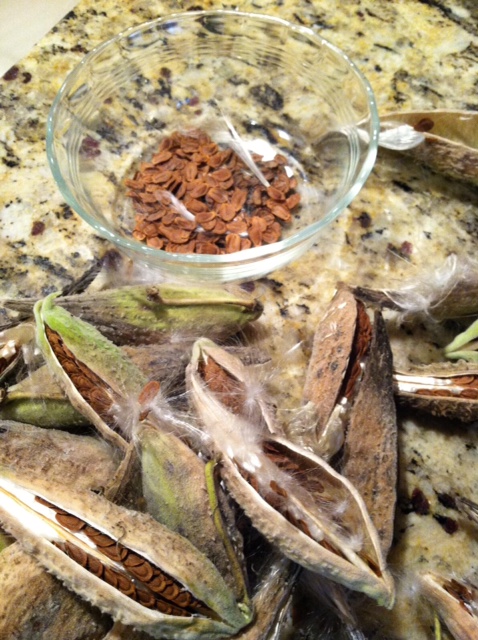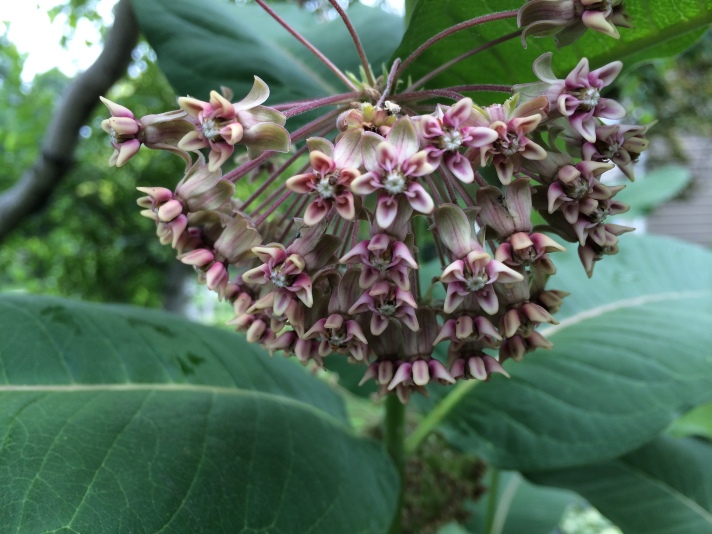Milkweed pods in my area are ripening. These pods were collected by my friend T in northern Wisconsin. She is busy preparing the mature seeds to scatter in her meadow. If you’re interested in helping to scatter the seeds, here is some great information from the Friends of the Monarch Trail in Milwaukee:
Harvesting of Milkweed Seeds
The timing of the collection of milkweed pods or seeds is critical. Mature pods are those that are within a day of two of opening. If you squeeze the pods and they don’t open easily, they usually do not contain mature brown seeds. Seeds that are into the process of browning and hardening will germinate when planted next season.
When collecting pods please be careful not to get the latex “milky” substance near your eyes. Also please make sure that there are no bugs in your collection of pods.
A plastic bag may be a convenient collection bag but it is not a good storage bag because when the pods/seeds are left in the plastic bag they have a tendency to get moldy. For more information about the nation wide endeavor to save the monarchs, please check out the website http://www.monarchwatch.com/milkweed/prop.htm” which has this to say about the subject:
Pale or white seeds should be not collected. Freshly collected pods dry should be dried in an open area with good air circulation. Once the pods are thoroughly dry, the seeds can be separated from the coma, or silk-like ballooning material, by hand. Separation of seeds can also be accomplished by stripping the seeds and coma from the pods into a paper bag. Shake the contents of the bag vigorously to separate the seeds from the coma and then cut a small hole in a corner of the bottom of the bag and shake out the seeds. Store dried seeds in a cool, dry place protected from mice and insects – a plastic bag (reclosable) or other container in the refrigerator works well.
Vernalization
Seeds of most temperate plants need to be vernalized, which is a fancy way of saying that they need cold treatment. The best way to give the required vernalization is through stratification. To stratify seeds place them in cold, moist potting soil (sterilized soil is best but is not required) in a dark place for several weeks or months. Since most people prefer not to place potting soil in their refrigerators, an alternative is to place the seeds between moist paper towels in a plastic bag. This procedure works well, in part because there are fewer fungi and bacteria available to attack the seeds. After a vernalization period of 3-6 weeks, the seeds can be planted in warm (70˚F), moist soil. Without vernalization / stratification, the percentage of seeds that germinate is usually low. Seeds from the tropical milkweed, Asclepias curassavica (and other tropical milkweed species) do not require this treatment. “Shocking” seeds that have been refrigerated by soaking them in warm water for 24 hours also seems to improve germination rates.
Scarification
Even after vernalization / stratification, seeds of many plant species will not germinate. In these cases, the seed coats appear to require action by physical or chemical agents to break down or abrade the seed coat. “Scarification” with some type of physical abrasion that breaks the seed coat usually works and can be accomplished by placing the seeds in a container with coarse sand and shaking the container for a 30 seconds or so. Scarification may be required for some milkweeds (e.g., A. viridiflora and A. latifolia) and might improve the germination rates of other species.

